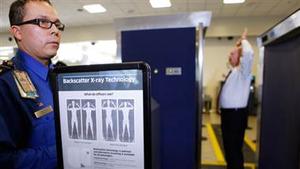Aviation securityFull-body scanning for the shy
The Transportation and Security Administration will soon launch Full Body Scanning 2.0 at several New York area airports; the new software, known as Automated Target Recognition (ATR), will auto-detect items that could pose a potential threat that passengers might be carrying under their clothes, but the suspicous items will be shown against a generic outline of a person for all passengers

Scans display contraband against a generic figure // Source: cheapoair.com
The Transportation and Security Administration will soon launch Full Body Scanning 2.0 at several New York area airports. Individuals who are shy about or uncomfortable with the detailed image of their bodies that appear on the screeners’ computers should welcome the news.
The new software, known as Automated Target Recognition (ATR), will auto-detect items that could pose a potential threat that passengers might be carrying under their clothes. The suspicious items, though, will be shown against a generic outline of a person for all passengers.
PC magazine reports that the new software will be installed at Newark, LaGuardia, and JFK airports by the end of the year.
“Our top priority is the safety of the traveling public, and TSA constantly strives to explore and implement new technologies that enhance security and strengthen privacy protections for the traveling public,” TSA Administrator John Pistole said in a statement.
TSA successfully tested the new software at Hartsfield-Jackson Atlanta International, Las Vegas McCarran International, and Ronald Reagan Washington National airports, according to the agency.
“This is a positive step forward to improve TSA’s screening procedures at U.S. airports through increased privacy for individual travelers,” said Representative Mike Rogers (R – Alabama), the chair of the House Homeland Security Subcommittee on Transportation Security.
The announcement comes in response to fierce criticism over the airport scanners which passengers and privacy groups say are too revealing. Last week, a federal appeals court rejected a lawsuit filed by the Electronic Privacy Information Center (EPIC) that argued that the scans violated the Fourth Amendment which protects against unreasonable search and seizure. The group said that the “naked” images are too graphic.
Ginger McCall, EPIC’s open government counsel, called TSA’s recent announcement a “pretty substantial change in agency policy.”
The group wants TSA to go even further and publish the technical specifications of the software, but the agency has declined.
Meanwhile other privacy groups like the Association for Airline Passenger Rights want the agency to stop using the scanners all together.
Brandon Macsata, the executive director of the airline passenger association said, “We feel there are better ways to balance security and privacy.”
According to Greg Soule, a spokesman for TSA, the new software will be installed on the full body scanners in “the coming months.”
Currently there are roughly 500 body scanners deployed across seventy-eight airports in the United States. The scanners are manufactured by Rapiscan Systems, a division of L-3 Communications and OSI Systems Inc. All new scanners will already come equipped with the technology.
